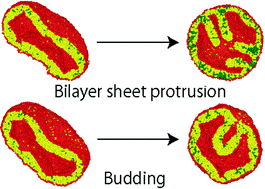Bilayer sheet protrusions and budding from bilayer membranes induced by hydrolysis and condensation reactions†
Abstract
Shape transformations of flat bilayer membranes and vesicles induced by hydrolysis and condensation reactions of amphiphilic molecules are studied using coarse-grained molecular dynamics simulations. The hydrolysis and condensation reactions result in the formation and dissociation of amphiphilic molecules, respectively. Asymmetric reactions between the inner and outer leaflets of a vesicle can transport amphiphilic molecules between the leaflets. It is found that the resulting area difference between the two leaflets induces bilayer sheet protrusion (BP) and budding at low reduced volumes of the vesicles, whereas BP only occurs at high reduced volumes. The probabilities of these two types of transformations depend on the shear viscosity of the surrounding fluids compared to the membrane as well as the reaction rates. A higher surrounding fluid viscosity leads to more BP formation. The inhomogeneous spatial distribution of the hydrophobic reaction products forms the nuclei of BP formation, and faster diffusion of the products enhances BP formation. Our results suggest that adjustment of the viscosity is important to control membrane shape transformations in experiments.



 Please wait while we load your content...
Please wait while we load your content...